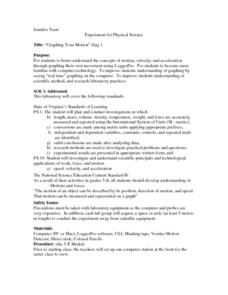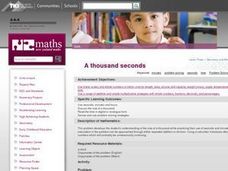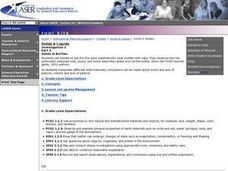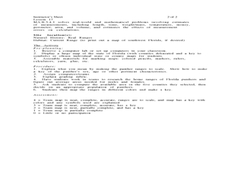Curated OER
Unit Perimeters and Areas
Students use Geometers SketchPad to find the area and perimeter of several shapes. In this geometry lesson, students determine area of rectangles and progress through irregular polygons. None of the referenced worksheets are included...
Curated OER
Learning by Sorting
Students sort Lego Duplo pieces after determining the attributes to classify them by. They work in pairs to sort a group of Duplo pieces and explain their process to others.
Curated OER
Henry Builds A Cabin
Learners listen to the book "Henry Builds a Cabin." They design a cabin using Lego pieces based on information from the story.
Curated OER
Houses
Third graders use a number of problem solving strategies in this unit of lessons. They determine how to draw and model three-dimensional objects, use co-ordinate systems, determine probability of events, and identify paths of simple...
Curated OER
Graphing Your Motion-Day 1
Ninth graders explore the concepts of motion, velocity and acceleration through graphing their own movement using LoggerPro. They become more familiar with the computer technology. Students explore graphing in real time and graph on...
Curated OER
Rice (Gohan) Observations
Second graders investigate rice or gohan as it's called in Japan in a couple of experiments. They tally the results.
Curated OER
Float My Boat
Fourth graders, in groups, experiment with density and the displacement of water by creating and designing their own boats and seeing which boat holds the most centimeter cubes without sinking..
Curated OER
Worms and more
Students have early length experiences must develop an awareness of what length is, and of the range of words that can be used to discuss length. Young children usually begin by describing the size of objects as big and small. They...
Curated OER
Prints and Outlines
Learners determine the area of two objects by superimposing one on the other. They compare and order the area of different shapes by covering a larger shape with similar smaller ones. They complete these activities as different stations.
Curated OER
Visiting Grandma
First graders investigate the aspect of time, including days of the week using a calendar. They use problem solving strategies and a monthly calendar to find a solution to the problem.
Curated OER
A thousand seconds
Pupils use seconds, minutes, and hours. They then discuss the size of a thousand. After that they read time in digital or analogue form.
Curated OER
Parking Meters
Third graders are introduced to the problem with a short discussion about parking. They then solve with a partner. As they work ask questions that focus on the strategies they are using to make the calculations.
Curated OER
Adam's Watch
Third graders use their watches to tell the time while the teacher lists their responses on the board along with the reasons for them (set incorrectly, gain/lose time). They solve the problem in pairs and focus their thinking on the...
Curated OER
Solids in Bottles
Students use funnels to put the five solid materials into clear bottles with caps. They observe how the particulate materials look, sound, and move when they shake and roll the bottle. Finally, students write "sound and touch" poetry.
Curated OER
Toothpick Bridges
Students study the techniques of building a bridge. They explore different type of bridges and then plan and build a bridge to specified instructions. Students draw plans, keep a budget, and prepare balance sheets during their bridge...
Curated OER
Home on the Range
Young scholars use maps and mathematics to determine the appropriate panther population in a given area. In this Florida ecology lesson, students research the area requirements of male and female panther and use a map to help calculate...
PBS
Pbs Kids Afterschool Adventure!: Operation: Measuring How Much Activity Plan
Measuring fun is here! In this week's adventure, children will explore volume, capacity, and weight and learn new math vocabulary words as they practice measurement with real and virtual measuring tools. Each section of this weeklong...
Alabama Learning Exchange
Alex: Weight vs. Capacity
This lesson plan will introduce students to measuring weight, mass, volume, and capacity using metric and cutomary units. This lesson plan was created by exemplary Alabama Math Teachers through the AMSTI project.
PBS
Pbs Mathline: It Takes Ten Lesson Plan [Pdf]
Learners rotate from station to station completing activities involving measurement weight, length, and volume using metric measurement.
PBS
Pbs Teachers: Scientific American: The Intimate Machine: Weighing In
Explore the "intelligent floor," which contains sensors that can track movements, and emulate the weighing technique associated with this technology. Explore the relationship between volume and mass and the difference between accuracy...
University of Texas at Austin
Mathematics Teks Toolkit: What's Poppin
Compare weights and volumes using popped and unpopped popcorn.
Alabama Learning Exchange
Alex: Souper Scooper
This hands-on, inquiry based lesson is an extension of the AMSTI Science Module, Solids and Liquids. Young scholars use nonstandard units to measure beans in a soup mix. Students predict how many beans will be in a scoop. Young scholars...
PBS
Pbs Mathline: Sand Babies (Pdf) [Pdf]
In this engaging lesson, students use a variety of measurement strategies in creating their own Sand Babies. Students explore standard and non-standard measurements, area, data collection and analysis, and graphing. Adaptations are...
Other
Pbs Mathline: It Takes Ten (Pdf) [Pdf]
A metric measurement lesson plan using grams, milliliters, and centimeters. This lesson offers a variety of "hands on" measurement activities using both the customary and metric systems. Additionally, this lesson plan offers extensions,...




